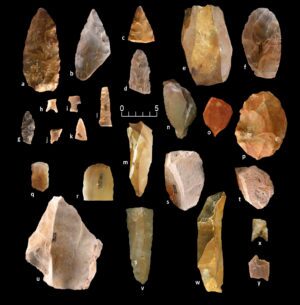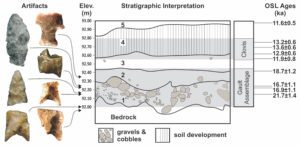
AAAS—In the lowest layer of the Area 15 archaeological grounds at the Gault Site in Central Texas, researchers have unearthed a projectile point technology never previously seen in North America, which they date to be at least 16,000 years old, or a time before Clovis. While clear evidence for the timing of the peopling of the Americas remains elusive, these findings suggest humans occupied North America prior to Clovis – considered one of the oldest, if not the oldest, Paleo-Indian culture of North America, and dated to around 11,000 years ago. In 2002, Area 15 of the Gault Site in Central Texas was identified as an ideal area to search for remnants of early cultures. The site features five distinct layers in the stratigraphic profile that showcase different cultural components, each with stratigraphic separation between the cultural depositions. Here, Thomas J. Williams and colleagues focused on the Gault Assemblage, the oldest deposit, which they compared to materials found in the Clovis layer (stratified above the Gault Assemblage). Based on optically stimulated luminescence (OSL) dating, the Gault Assemblage sediment samples are approximately 16- to 20-thousand-years-old, the authors say. Additionally, Williams et al. discovered ancient materials in the lowest Gault deposit, including small projectile point technology, biface stone tools, blade-and-core tools, and flake tools. The authors compared these Gault Assemblage artifacts to Clovis tools and found that the blade-and-core traditions, in particular, are similar to Clovis blade-and-cores (meaning they continued into the time of Clovis), but biface traditions underwent significant changes in the Clovis level. Meanwhile, the early projectile point technology is “unrelated” to Clovis at all, they say.
_________________________________

Stone tool assemblage recovered from the Gault Site. Produced by N Velchoff ©The Gault School of Archaeological Research
_________________________________

Gault Assemblage projectile point fragments with soil layers and ages. Produced by A. Gilmer ©The Gault School of Archaeological Research
________________________________
Article Source: A Science Advances news release Science Advances is published by AAAS, the nonprofit science society.
See the feature articles about early Homo sapiens in Africa and Arabia in the Summer 2018 issue of Popular Archaeology.
_________________________________
Join us on this incredible journey!


